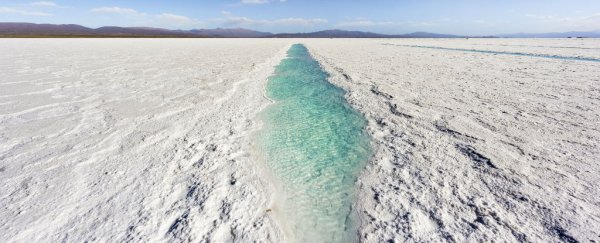Researchers have developed a system that uses an electric shockwave to extract salt and other impurities out of salty or contaminated water, and say it could be scaled up for use in desalination or water purification plants, or be used to clean the vast amounts of dirty water produced by fracking.
Known as 'shock electrodialysis', the technique applies an electrically driven shockwave to a constant stream of flowing water. The current interacts with the charged salt particles, causing a stream of salty water to be pushed aside and separated from a stream of fresh water, and these are then funnelled into separate pipes.
A cheap and efficient desalination process that converts salty, brackish, or contaminated water into fresh, clean water would change the world in ways we can only dream about, but so far, no one's been able to perfect it.
One of the most popular techniques is reverse osmosis, which separates water molecules from larger particles - e.g. salt and impurities - but the filters used are easily clogged, which limits the capacity of the system. And boiling the impurities out of water to make it drinkable sounds simple, but it requires so much energy, scientists are yet to figure out how to make it cost-effective.
So engineers at MIT decided to take a whole new approach, and investigated what happens when you mix water and electricity. The salty or contaminated water is fed through a cheap and porous material called a frit, made from tiny glass particles, flexible membranes, and electrodes. As it flows, an electric current is applied to the water, and interacts with the salt content of the water.
David L. Chandler explains what happens next over at MIT NEWS:
"When an electric current flows through the system, the salty water divides into regions where the salt concentration is either depleted or enriched. When that current is increased to a certain point, it generates a shockwave between these two zones, sharply dividing the streams and allowing the fresh and salty regions to be separated by a simple physical barrier at the centre of the flow."
The system is based on the same concept as other desalination or water purification techniques, but has one fundamental difference. In systems based on reverse osmosis, the dirty or salty water is passed through special membranes that catch salt particles and other impurities. In the MIT system, membranes are also used as barriers for contaminants, but instead of flowing through the membranes, the water flows across them.
This "membraneless separation", as the team calls it, does away with the huge problem with reverse osmosis - when the accumulation of filtered material becomes so much, it blocks the system and causes a dangerous build-up of water pressure.
"This process looks similar, but it's fundamentally different," says one of the team, engineer Martin Bazant. "The salt doesn't have to push through something, [the charged salt particles] "just move to one side."
Describing the new system in the journal Environmental Science and Technology Letters, the team says their system can work with a continuous stream of contaminated water, and while they've so far only tested its proficiency in the lab, they think it could be easily scaled up for commercial ventures, because it requires so little infrastructure. This could also mean the system could be applied to portable systems for remote areas.
"One possible application would be in cleaning the vast amounts of wastewater generated by hydraulic fracturing, or fracking," says Chander at MIT News. "This contaminated water tends to be salty, sometimes with trace amounts of toxic ions, so finding a practical and inexpensive way of cleaning it would be highly desirable."
The electric fields applied to the water are relatively high voltage, which means the process could not only filter out dirt and salt, but harmful bacteria too. This suggests the system could be used to sterilise contaminated water for drinking.
But this isn't the only promising new desalination technique being developed right now. Researchers in Egypt have been developing a system based on the process of pervaporation, which can desalinate water with as much salt as the Red Sea. Meanwhile, engineers from the University of Illinois announced earlier this month that they've developed a material that allows high volumes of water to pass through extremely tiny 'nanopores' while blocking salt and other contaminants.
